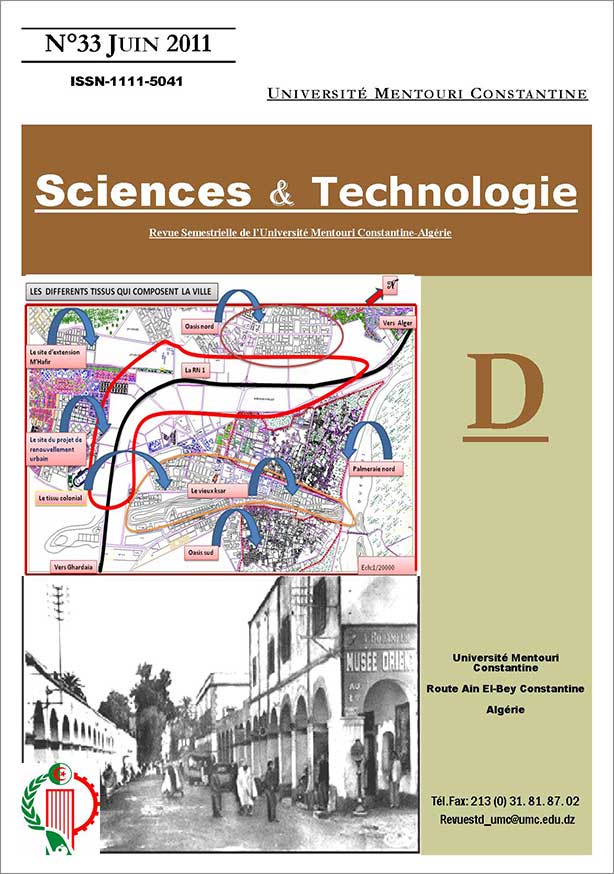A NEW APPROACH OF LOW ANNUAL ENERGY DOMESTIC BUILDING CONSUMPTION IN ALGERIA ON ‘HPE’ CONCEPT
Mots-clés :
Air pollution, environmental strategy, sustainable transport, tram, ConstantineRésumé
This paper develops a simple modeling tool for designer green buildings. The designer can explore the nature of building, shape, fenestration, orientation and fabric thermal properties to minimize a buildings’ environmental effect. Aspects of heating, lighting, natural and mechanical ventilation with heat recovery systems can also be investigated. The model is best used to check that buildings will observe with the regulations or used as an early design aid rather than a detailed design simulator of building performance. The program should therefore be of particular interest to architects, building surveyors and building controllers rather than building service engineers. A project pilot program in Algeria has been lunched based on low energy consumption. It has been increasingly realized that the preservation of the environment is a guarantee of durability and stability of the process of economic and social development. Daily life in domestic buildings (heating, air conditioning) is responsible for more than 30% of emissions of greenhouse effect gases. It also appears that a suitable building construction and an adequate implementation can both reduce energy bills and household expenditure. Acting on buildings and environment, is to give all Algerians possibilities to live in an ecological habitat. That is why measures will be implemented which affects both existing buildings (over 7 million homes on 1 January 2007) during their rehabilitation and the new buildings as well. A large number of residential constructions do not seem responding to thermal comfort and energy savings needs. This can be explained by the absence of specific thermal regulations and, also, by the lack of know-how and an insufficient knowledge on the topic by the builders. A thermal calculation method has been developed taking into account the new HPE ‘High Performance Energy’ a voluntary process, which promotes high quality research in a sustainable development perspective. It is also essentially based on a new way of behaving in an indoor environment comfort, in order to reduce to the minimum the cost of energy used to heat the new or existing buildings. The recommendations of the centre of thermal regulations developed for the Algerian climate are taken as references in the choice of the computer model elaborated in our study as a tool. A personal program, named “EnergyArch” that models both outside and inside parameters acting on the building, using the thermal simulation of the architectural parameters and the climatic factors of the region. This program has reached an energy saving of about 20% by households depending on the construction materials used
Références
Durmayaz A, Kadıoglu M, Sen Z. An application of the degree-hours method to estimate the residential heating energy requirement and fuel consumption in Istanbul. Energy 2000;25(12):1245–56.
CNERIB, 1998. Algerian Center for Studies and Research integrated of buildings. D.T.R. C3-2 & C 3-4; rules for calculating heat loss, Issue 1 & rules for calculating the heat gain of buildings.
LAWSON, B. R. (1990). From drafting to intelligent systems. In CAD im Architekturburo: ACS-90, (pp. 29-36). Wiesbaden Germany, ACS.
MENEZES, A. and LAWSON B.R. (2006) How designers perceive sketches Design Studies 27 (5), pp. 571-585)
[On ligne] Ministry of Economy Finance and Industry,
/11/2004. « 20 ans de chauffage dans les résidences
principales en France de 1982 à 2002. Observatoire de l'énergie. Octobre 2004 http//www.industrie.gouv.fr/energie/statisti/se_stats14.ht
m#1 (Consulted Page on 05 march 2006)
Office national de la météorologie de SETIF, BOUGAA, Base de données de température externe moyenne (1990-2004).
SAMIR FOURA, ZEROUALA M.S, 2007; Simulation des paramètres architecturaux du confort thermique d’hiver en Algérie, 2007. Sciences et Technologie D – N°26 Décembre (2007). Pp 76-85energy program.
APRUE C.T.I Computer Center and Technics of APRUE, SETIF, BOUGAA, « Tournée 23 Commune du 20 Août 25501 », 2005.
Ministère de l’habitat et de l’urbanisme –(Commission Technique Permanente, Réglementation thermique des bâtiments d’habitation et règles de calcul des déperditions calorifiques, Document Technique Réglementaire, CNERIB, Décembre 1997, Alger, Algérie.

